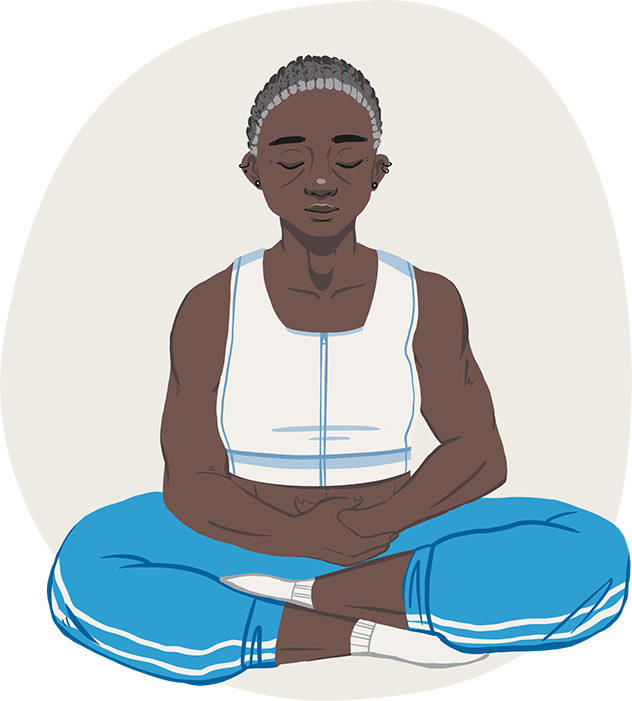When feelings get stuck
Learn about working through difficult emotions.

Sometimes we are taught shame about ourselves, our bodies and our desires, especially as trans, Two-Spirit A term used within some Indigenous communities to reflect complex Indigenous understandings of gender and sexuality and the long history of sexual and gender diversity in Indigenous cultures. Two-Spirit encompasses sexual, gender, cultural and spiritual identity. It may refer to cross-gender, multi-gender or non-binary gender roles, non-heterosexual identities, and a range of cultural identities, roles and practices embodied by Two-Spirit peoples. Some people also use "2-Spirit" or "2S." (Source: Battered Women’s Support Services) and non-binary Umbrella term referring to people whose gender does not fall within the binary gender system of woman/girl or man/boy. Some individuals identify as non-binary while others may use terms such as gender non-conforming, genderqueer, or agender. Non-binary people may or may not conform to societal expectations for their gender expression and gender role, and they may or may not seek gender-affirming medical or surgical care. people. We can feel at risk in many different environments. In the presence of stress and fear, it can be difficult to feel pleasure, comfort and ease.
Stress
Much of the time, our bodies are well-equipped to deal with stress.
Our nervous systems move between two states in response to stressors.
- Fight-flight-freeze-appease response: When we experience stress, the sympathetic nervous system activates our "fight-flight-freeze-appease" response. This increases our heart rate, widens our pupils and slows digestion.
- Rest and digest: When we return to a feeling of safety, the parasympathetic nervous system activates our "rest and digest" functions. This decreases our heart rate, constricts our pupils and activates digestion. (Under extreme stress, this same system can sometimes cause fainting or other shut down responses as a form of protection.)
With every breath we take, we can feel the give and take of these two parts of our nervous system. As you breathe in, you might notice a slight increase in your heart rate as you gently activate your sympathetic nervous system. As you breathe out, your heart rate might decrease slightly as you gently activate your parasympathetic nervous system.
Our bodies are able to move through many of the stressors we experience day-to-day, and bring us back to a state of calm rest. However, sometimes, our stress responses can become stuck, leaving us feeling activated or shut down. This can be referred to as “dysregulation”.
When stressors are chronic, such as ongoing prejudice, incongruence, dysphoria, or harassment, we may not ever feel fully safe. In these situations, we can find ways to intentionally relax and release our bodies from the effects of stress.
Some ways to release stress include:
- Exercise
- Breathing techniques
- Positive social interaction
- Laughter or tears
- Gestures of affection
- Creative self-expression
Finding play in the give and take
While chronic stress can lead to dysregulation, the same pathways also support excitement, pleasure, passion and vitality. This aliveness and arousal are not problems to be solved.
Our sympathetic nervous system is designed to awaken us, prepare us for action, and infuse us with vitality. For some people, especially trans, Two-Spirit A term used within some Indigenous communities to reflect complex Indigenous understandings of gender and sexuality and the long history of sexual and gender diversity in Indigenous cultures. Two-Spirit encompasses sexual, gender, cultural and spiritual identity. It may refer to cross-gender, multi-gender or non-binary gender roles, non-heterosexual identities, and a range of cultural identities, roles and practices embodied by Two-Spirit peoples. Some people also use "2-Spirit" or "2S." (Source: Battered Women’s Support Services) and non-binary Umbrella term referring to people whose gender does not fall within the binary gender system of woman/girl or man/boy. Some individuals identify as non-binary while others may use terms such as gender non-conforming, genderqueer, or agender. Non-binary people may or may not conform to societal expectations for their gender expression and gender role, and they may or may not seek gender-affirming medical or surgical care. folks, reclaiming these pathways is an essential part of healing. This might include ‘safe-enough’ explorations of pleasure and intimacy, creative self-expression, or playful embodiment. ‘Safe enough’ means staying within what feels manageable while allowing for gentle exploration. There are many ways to come home to ourselves.
Trauma
Severely distressing events, such as experiences of emotional, physical or sexual harm, can leave lasting impacts on our minds and bodies. These overwhelming experiences and their ongoing effects are both referred to as trauma.
During a distressing event, our bodies and minds might protect us by disengaging, dissociating, going numb, becoming angry, or running away. After the event, our bodies may react as if we are in danger more often, even when we know we are safe. This is called hypervigilance. When we are hypervigilant, we are always on our guard, and may become less able to tolerate feelings of uncertainty, unfamiliarity, or discomfort.
We can experience ongoing effects, such as:
- Finding it difficult to be present within or connected to our bodies.
- Experiencing emotional overwhelm or numbness when situations (for example, a sound, touch, sight, or location) remind us of trauma.
- Having difficulty going into public spaces, or feeling anxiety or numbness when in public.
- Finding it challenging to form relationships or make community connections.
It is normal to react to distressing events in these ways, and it is normal to need help returning to a place of feeling safe and able to connect to others.
Moving through trauma, stress and other difficult experiences
There are many approaches that can help people work through trauma, stress and other difficult experiences. These may include talk therapies, body-based and movement practices, traditional wellness and healing practices, and medication. Consider speaking with a health care provider, mental health professional or Elder to learn about options and find what feels right for you.
The resources linked below may also be helpful if you are trying to connect or re-connect with your body.
Feeling safe-enough
As we move through the world, learn new things, explore ways of being in our bodies and process difficult emotions, it’s important to do so from a place of safety. For some of us, it can be very hard to feel truly safe. By paying attention to our emotions and our bodies’ reactions, we can learn what it feels like to be safe-enough to try something new.
Understanding hyperarousal and hypoarousal
When we are in danger, or feel that we are in danger, our bodies enter a state of:
- Hyperarousal, when our "fight or flight" instinct is activated.
- Hypoarousal, when we freeze, become numb, shut down or space out.
Personal growth can happen when we find a balance between feeling challenged with feeling safe. As we practice connecting with our bodies and ourselves, some practices might bring us to the edge of what feels manageable. Learning to recognize when we are entering a state of hyperarousal (overwhelm) or hypoarousal (shut down) can help us return to feeling safe-enough for our bodies to be receptive to new positive experiences.
Threat
management
Safe-enough – Sympathetic nervous system
This might feel like: anxiety, anger, hypervigilance, restless thoughts
Tolerance &
learning
Safe-enough – Sympathetic nervous system
This might feel like: manageable stress, excitement
Comfort
Comfort zone – Sympathetic nervous system
This might feel like: confidence, aliveness, stability
Comfort
Comfort zone – Parasympathetic nervous system
This might feel like: relaxation, resilience, openness to new experiences
Tolerance &
Learning
Safe-enough – Parasympathetic nervous system
This might feel like: manageable challenge, delayed reactions
Threat
Management
Hypoarousal – Parasympathetic nervous system
This might feel like: apathy, freezing, numbness, fuzzy thoughts
Self-regulation
Many people develop a toolbox of self-regulating behaviours without really thinking about it. We use these behaviours to calm and comfort ourselves if our nervous system is hyperaroused, or to activate our physiology if our nervous system is hypoaroused. Effective self-regulating behaviours engage the senses and bring us back into the present moment.

Self-regulating behaviours include:
- Deep breathing
- Grounding exercises (for example, listing things you can see, hear, smell, or taste; eating something sour; doing a body scan)
- Offering yourself soothing or grounding touch, such as tapping, stroking, or squeezing your arm or thigh
- Walking, running, or skipping rope
- Playing with a fidget toy
- Putting on music and dancing
Sometimes self-regulating behaviors may carry health risks or social challenges (such as substance use, self-harm or compulsive activities), but they are often creative attempts to manage overwhelming emotions. When we view these activities with compassion and curiosity rather than judgment, we can see more choices available to us and reduce the shame that can make change feel out of reach.
Self-regulating behaviours can involve others
Performing acts of kindness and generosity can comfort the nervous system of both giver and receiver. Touching and holding an animal or person, or being touched and held, can help us feel grounded, valued and right with the world.
You can also ask trusted people to help:
- Regulate with you (co-regulation): Try breathing exercises, grounding techniques or calming activities together.
- Help you regulate: Ask someone to guide you through self-regulation tools when you are feeling overwhelmed (for example, talking you through a breathing exercise, and giving a long, slow hug.)
- Provide connection: Sometimes just being with someone you trust, talking, or sharing physical comfort can help your nervous system settle.
- Practice together: Work on self-regulation skills with friends, family or support people when you are already feeling calm, so these tools are familiar when you need them.
Connection with others is one of our most powerful tools for finding safety and calm.
Self-regulating behaviours can invoke spirit
Self-regulation can also draw on spiritual or meaningful connections. You might find your physiology and emotions can be soothed by focusing on what is truly important to you. You might find peace through a sense of alignment with the earth, the sacred, or a higher power. You may have connections with ancestors, Elders, spiritual traditions, or other sources of guidance and meaning.
Ways to engage your nervous system
For more suggestions on ways to engage your nervous system in times of distress, explore this resource:
Resources
To learn more about supporting your body to experience and process difficult feelings, see the following resources:
- Science for Sexual Happiness: A Guide to Reclaiming Erotic Pleasure by Caffyn Jesse
- You Are Made of Medicine: A Mental Health Peer Support Manual for Indigiqueer, Two-Spirit, LGBTQ+ and Gender Non-Conforming Indigenous Youth from the Native Youth Sexual Health Network
- The Queer A reclaimed term for non-heterosexual or non-cisgender people. "Queer" provides convenient shorthand for "LGBT2Q+", and is also used by some people to describe their personal identities. and Transgender Resilience Workbook: Skills for Navigating Sexual Orientation Refers to terms such as lesbian, gay, straight, and queer, which are based on patterns of emotional, romantic, and/or sexual attraction to groups of people. Sexual orientation terms are commonly (but not always) defined by the gender(s) of the people that the individual is attracted to. Sexual orientation also refers to a person’s sense of identity based on those attractions, related behaviors, and membership in a community of others who share those attractions; for example pansexual, bisexual, LGB, heterosexual. and Gender Expression by Anneliese Singh
- Burnout: The Secret to Unlocking the Stress Cycle by Emily and Amelia Nagoski
- What It Takes to Heal: How Transforming Ourselves Can Change the World by Prentis Hemphill
- Undrowned: Black Feminist Lessons from Marine Mammals by Alexis Pauline Gumbs
- The Neural Learning Zone: Safe Enough to be Brave by Caffyn Jesse
- Heads Up: Trans Guide to Mental Health and Wellbeing by Transgender Equality Network Ireland
- A Self Help Guide to Healing and Understanding: for Transgender Sexual Violence Survivors from FORGE


